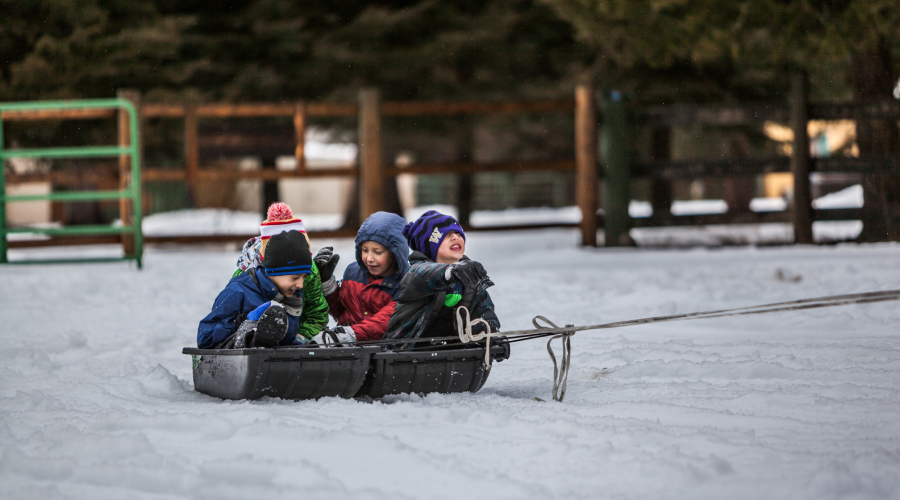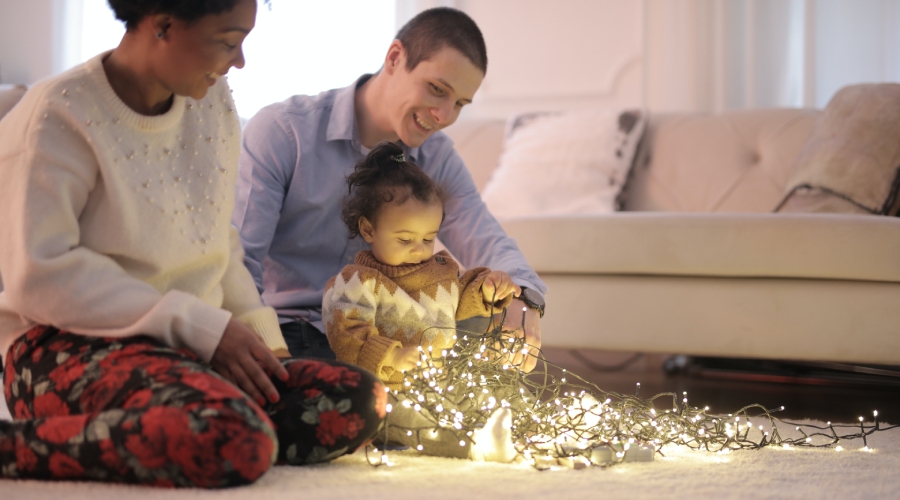settings
children
With Famly since
I love Christmas. And yet here I am, writing an article about why we need to do a little less in our early education settings to celebrate it.
So before you worry that this is another "bah humbug" article from a Yuletide-hating anti-Christmasser, I want you to know I’m writing this while watching Christmas movies in mid-November. I guess this year I needed that Christmas magic and sparkle earlier than usual.
That being said, every year as I get lost in the anticipation and build-up, I worry about how we present Christmas to our children in early education, and whether we really consider the disruption it can cause. Sometimes, our well-meaning Christmas plans can be an unwelcome change for our routine-focused little ones, or create unnecessary stress for the grown-ups involved in making Christmas happen.
Recent years have proved us that we can tweak our approach to Christmas. Just as many people celebrated Eid, Diwali, birthdays, weddings and all manner of other celebrations a little differently during the pandemic, we found ways to adapt our habits and expectations, and make an experience that was warm and lovely all the same — if a little different.
So why not carry those lessons forward? I think it’s a good time to reflect on what’s best for the child at Christmas, and how we can plan our activities for them, and stop overwhelming ourselves with expectations in the meantime. Let's explore what that might look like.

Why should we rethink our approach to Christmas in early childhood?
Disruption is difficult for even the most grownup of brains, but neuroscience research tells us that little brains feel it too.
It might not seem like it, but decking our settings out in Christmas gear may not be the best idea. When children come back after a weekend at home to find their safe, familiar early years environment has been completely taken over by a red, green, and fluffy white Christmas, it’s worth considering just how disruptive this can be.
We need to ask ourselves, is this overnight change the best thing for their happiness? Their development? What about their sense of safety and security in what has already been a difficult year?
And what about Christmas plays, nativities, carol singing, turning out conveyer-belt style arts and crafts stuck with cotton-wool snow, when some children have never seen the real thing … are they really the best thing for our children either?
Finally, it’s worth being honest with ourselves: preparing for christmas can be stressful. Prep for pantomimes, carol concerts and endless card making can take its toll on even the most dedicated Christmas fan. If we want to keep children at the heart of the magic and sparkle, having adults who are enjoying – rather than stressing – about what should be a magical time is probably a good place to start.
Before we go onto how we can keep keep that magic and sparkle at the heart of Christmas for our children, here are some questions you can use to reflect on your Christmas plans:
- Are our plans something that we enjoy doing, or are they adding to our team’s stress?
- How much of our environment are we changing overnight?
- Are our plans really about the magic and sparkle of christmas? Do they embrace the magic of childhood?
- Who exactly are our Christmas plans for? The children, the parents, or us?
- Who exactly do our Christmas plans benefit, and how?
- How do our plans fit into the context of our broad, multi-cultural society?
The big ideas

What do children look for in their early education environment?
Before I give you some ideas for a more child-focused Christmas environment, let’s start by thinking about what children enjoy.
To partly misquote Urie Bronfenbrenner, children enjoy being with ‘irrationally crazy’ adults.
In other words – adults who have fun, are happy, like playing and who enjoy being with them. Children enjoy arts and crafts, singing, dancing, having fun, being outside and generally being…children.
None of that is completely separate from Christmas, but is there any reason why we can’t celebrate while still making sure all children are happy and comfortable in your setting?
Instead of thinking about what children want, maybe the answer is simply to ask them. Ask them questions like:
- Do you celebrate Christmas at home?
- If so, what is Christmas like for you?
- What sort of things do you do to decorate your home for christmas?
- What kind of things do you want to do over the next few weeks?
And ask ourselves questions like:
- What do you want the children to see or learn about Christmas?
- How much do they already ‘know’ and understand about Christmas?
- How much can the children be involved in decorating the setting themselves?
- How can the children be involved in the decisions about what is happening?
- What does Christmas actually mean to all of our children?

Ideas for a more child-focused Christmas
You know your children and families best, but here are a few suggestions for a more child-focused Christmas in your setting that you might like to consider as starting points.
1. Explore alternative arts and crafts
Arts and crafts can be child-focused, and still be full of sparkle and magic. They don’t have to be the same copy-and-paste snowman cards. Why not let the children offer their own ideas, and explore their own creative interpretations of Christmas?
Ask yourself, how can we support children to make self-directed, personalized cards and gifts that mean something to them? Let’s be honest, it doesn’t have to look like a Van Gogh copy to be treasured and loved by the parents and grandparents that get them.
2. Sing some new songs, share some new stories
Snuggling up with stories, songs and rhymes is something that can be enjoyed year-round. At Christmas, these times can become extra special. The literature and songs we find around this time are filled with magic, joy and colour, and the messages of kindness, sharing and thinking about friends and loved ones. Plus, children are hard-wired to enjoy singing songs with you.
Just make sure that you find stories and songs representative of every child’s experience. That might mean finding some more seasonal, wintery songs and stories rather than just ones about our version of this time of the year. If you'd like some ideas on how to source new songs and stories from children's home cultures, you can read up on that here.
3. Try some wintertime outdoor play
We’ve all been in situations where we have witnessed children who need to be outdoors. I’ve used the word need on purpose – I’m sure many of you will agree that there seems to be a biological need for children to connect with nature. And that need doesn't go away just because it's cold out.
Science agrees with us there too – that being outdoors is good for all of us. A recent study, for example, showed that "students who spent most of their time at home during the COVID-19 epidemic experienced better mental health when exposed to more greenery."
With the right planning (and clothing), there’s no reason we can’t consider some Christmassy outdoor activities too. Think about things like a themed treasure hunt around the garden, Christmas-related circle games, songs and rhymes, or, if you’re lucky and brave enough, even stories around a campfire. Here are 10 winter outdoor play ideas to help you get started.
4. Rethink the role of adults
Regardless of the themed activities you decide to do, the role you play as an adult is key.
Activities that are supported by adults who enjoy playing with, and spending time with, children, will always have an element of magic and sparkle. Ultimately, I suppose, Christmas is about ‘awe and wonder’ – and that’s the magic of childhood too.
Therefore, activities offered and supported by adults who believe in the magic of childhood will be full to bursting with awe and wonder for the children. Handled sensitively, child-led and with a bit of thought and planning, there is no reason why any of these activities shouldn’t have Christmas, winter, or other seasonal multicultural themes too.

Explaining all this to parents
There’s no doubt that the repetitive nativities, carols, and identikit cards still mean a great deal to parents and other loved ones. Scaling things back a little is likely to benefit the children, but it’s important that we take the time to help parents, who may have different expectations, understand that.
The following questions might help as starting points to explore your thinking.
- Who are these activities really for – is it for the children?
- What do the children gain, or benefit, from the activity?
- Why are we doing ‘this’ activity?
- Do the children actually want to do this?
- Does this bring that all important ‘magic & sparkle’ or ‘awe & wonder’?
- How do you know?
And my favourite question – if not, why not?
These are just some examples, and whatever you have planned, it doesn’t mean parents won’t get to enjoy some lovely Christmassy moments or gifts with their little ones. But once you take some time to explain to parents why you’re changing things, and why it’s being done with the children at heart, you’ll quickly get them onside too.
Debbie Garvey is a consultant, author & trainer, with over 35 years of experience across the Early Years sector. Debbie has particular interests in developing understanding of neuroscience and PSED for children and adults. You can connect with Debbie on Twitter @Stoneg8Training or through the website www.stonegatetraining.co.uk
Try learning journals for free
Add observations, and build digital learning journals to share with families instantly. All with your completely free 14-day trial.
Get started









